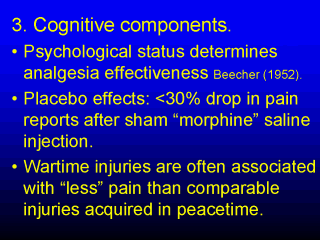| front |1 |2 |3 |4 |5 |6 |7 |8 |9 |10 |11 |12 |13 |14 |15 |16 |17 |18 |19 |20 |21 |22 |23 |24 |review |
 |
There is an extensive literature
on the variations that can occur in pain experience when cognitions are manipulated. In
World War II, Beecher, a surgeon with the US Marine Corps during the Normandy Invasion,
noticed that many soldiers removed from the battleground with serious, but non-life
threatening injuries (e.g. projectile injuries to the limbs) often did not seem to require
analgesia. However, civilians in non-combat situations receiving similar injuries seemed
to require substantial analgesia to control their pain. His subsequent studies revealed
that cognitive state was an important determinant of the need for analgesia. The placebo effect (a placebo is an inactive treatment of any kind given with the intention of creating a therapeutic effect) can produce significant decreases in levels of reported pain . People given an injection of saline but told that it is morphine report decrease in levels of pain of up to 30%. This reflects the effect expectations can have on the interpretation of what sensory activity means. Studies of psychogenic pain (pain experienced in the absence of identifiable tissue damage, but not “imaginary “) indicate that nociceptive sensation can become developmentally linked to certain contexts and emotional states, possibly through classical conditioning. When the certain context or emotional state is experienced, pain is generated through central processes, though no tissue damage has occurred. Finally, Melzack & Wall’s developmental studies of animals’ sensitivity to noxious stimuli strongly suggest that the interpretation of sensory information from tissue injury is learned. In other words, animals protected against opportunity for any kind of injury in early life are much less likely to respond with typical “pain behaviour” when exposed to noxious stimuli as adults. It therefore seems that learning, probably involving neuronal maturation, is necessary for the development of “pain” perception. This would be consistent with studies of the need for visual and auditory stimulation in early life for normal development of visual and auditory function. This is also likely to be influenced by constitutional characteristics of the CNS. |